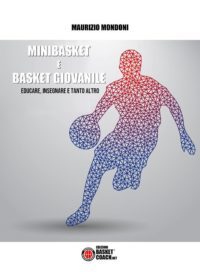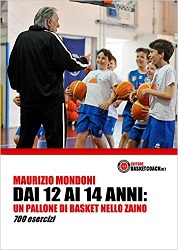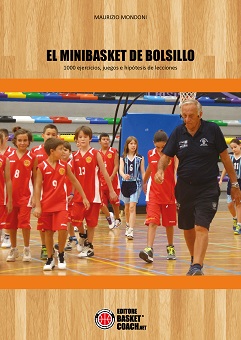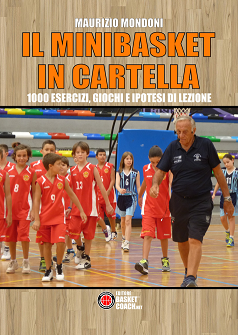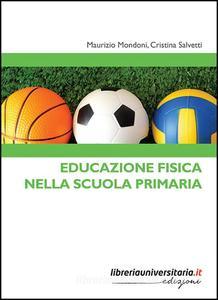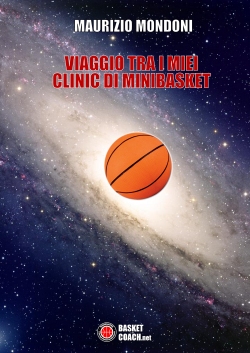The Base Game of Minibasket
The base-game (1 on 1, 2 on 2, 3 on 3, 4 on 4, 5 on 5) is the ideal starting point for a Instructor when teaching Mini-basketball after having built up a strong multilateral motor base.
1 on 1 base-game
The 1 on 1 base-game may be used in a simple manner with children in the 8-9 age groups and in a more complex fashion with children in the 10-11-12 age group.
At 8-9 years, the Instructor must accept that children cannot be expected to perform over-complicated gestures and movements, he/she must be patient and carefully observe players behaviour on court.
At the age of 10-11-12, more difficult gestures and movements can be expected, since the motor experiences of children have significantly increased and are therefore stored in the children’s minds.
The 1 on 1 base-game constitutes the initial situation from which Mini-basketball can be taught to children aged 8-9.
The following indications can be provided to children for the 1 on 1 situation:
– you cannot run while holding the ball;
– you cannot leave the court;
– you cannot dribble again after catching the ball;
– the player in possession of the ball must try to go where there is no opponent (explain how) and must decided immediately what to do, but must also change his/her plan if what he/she expected is not happening;
– the player in possession of the ball must seek to prevent his/her opponents from taking it away from him/her (sheltered dribbling, turning back);
– the player in possession of the ball must attempt to beat his/her opponents;
– offensive players not in possession of the ball must try to become unmarked;
– defensive players should not be beaten and must stand in front of their offensive opponent, whether he/she has the ball or not.
The Instructor must carefully observe children’s behaviour during the base-game and from the different situations arising on court he/she must infer what children cannot do or cannot do well, proposing drills and games useful for solving the problem.
For example:
– he/she may have observed that the child in possession of the ball does not know how to dribble in order to move on court, that he/she leaves the playing area, he/she does not change hands when dribbling, he/she cannot choose what sort of dribbling to use, he/she does not have a good control of the ball, he/she does not have the correct perception of this/her body and space, or he/she is unable to take quick decisions;
– the Instructor may on the other hand observe that the child defending commits too many fouls when trying to regain possession of the ball, he/she is uncoordinated, he/she possesses little balance, he/she does not perceive distances, or he/she is unable to dissociate the action of arms and legs.
At this point the Instructor must decide the needs to be attended first to help the children resolve the problems mentioned above.
The Instructor should propose useful drill-games to solve the problems, try to correct the main errors in performance (in doing so secondary errors may disappear) and must provide the children with simple but essential tips, that would help them understanding the game (logic applied to movement).
In order to do all this, the Instructor must know and apply the proper exercises. After the analytical work, the Instructor must re-apply the 1 on 1 base-game and verify whether the work performed has been productive.
In the 1 on 1 situation the child must gradually understand that dribbling helps to:
– move from defence to offense;
– beat one’s opponents;
– move nearer to the basket (enter, stop pass and shoot, shoot);
– improve the passing angle (when playing with teammates).
The 1 on 1 situation is practically a duel, the two contestants are both the offensive and the defensive player, being important for the players to change mentality (from offense to defence and the opposite).
Progressively players will must be able to know or understand when they need to change hands, direction or speed, when is better to pass rather than dribble and when it is better to shoot and how.
All of this called “anticipation and decision ability” which in the initial stages cause’s children to commit many mistakes when judging the situations and making the subsequent decisions.
Only after the child has understood “what” he/she must do, can he/she begin to work on “how” (performance technique) to obtain a better result.
It is possible to play 1 on 1 full-court, half-court or close to the basket.
The Instructor may function as a referee, running the game and stopping it in the event of rule violations, teaching the rules and being tolerant with younger children about their mistakes.
—————————————
ALTRI ARTICOLI GIA’ TRATTATI SUL BLOG NELLE CATEGORIE. CLICCA SULLE CATEGORIE PER LEGGERLI.
TECNICA
ESERCIZI
COMUNICAZIONE
SCUOLA E MINIBASKET
MINIBASKET NEL MONDO
PEDAGOGIA
FISIOLOGIA
VIDEO
SCARICA GRATIS LA MIA DISPENSA L’ALLEDUCATORE
Vi ricordo che potete iscrivervi alla mia newsletter gratuita, per restare sempre aggiornati sul #minibasket a misura di bambino. In regalo la dispensa l’Alleducatore.
Prof. Maurizio Mondoni
#iostoconibambini
#alleducatore
#minibasket
